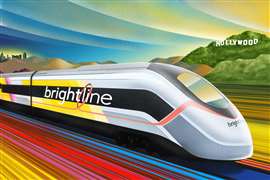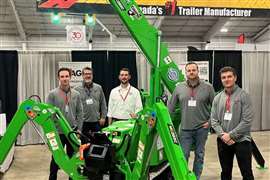Working together: A review of work leading to the safer use of mast climbing machines
03 January 2012

With the help of Kevin O'Shea of Mastclimbers LLC and chairman of IPAF's International MCWP committee, Access International reviews the cooperative work that will lead to the safer use of, mast climbing work platforms, transport platforms and hoists.
One of these days we're all going to wake up and the recession will be over! And, when that day comes some industries will emerge that are a little different in shape and style, and a little leaner than they were.
But the work an industry does during a recession can be some of the most important work it ever does. And the Mast Climber industry has been pretty busy during the last two or three years getting into shape for what will hopefully be good times ahead.
ANSI Standards
2011 has seen the release of a new important standard from ANSI (American National Standards Institute), A92.9 - Mast climbing Work Platforms and, in conjunction with the late 2009 release of A92.10 - Transport Platforms, it is a major step forward.
A92.9 is the first full revision of the 1993 Standard. The revision has the advantage of being very close to the EN1495 European Standard, and should facilitate relatively trouble-free imports and exports.
The A92.9 committee, having produced a much improved document, isn't standing still. It is already beginning to take and review comments on the standard.
A92.10, the transport platform standard, is an important document for the industry. It is the first official national document recognizing the transport platform in its own classification.
The transport platform has been widely received by users as a highly productive, cost-effective solution to small to medium scale construction projects where there is neither the budget or the sheer size and scale to warrant a traditional high volume construction elevator.
Members of the A92.9 and A92.10 Committees are also taking part in the ISO standards process.
ISO Standards
Work has commenced on an ISO standard for Transport Platforms and continuing guidance for mast climbing work platforms. The ISO/TC214 Elevating Work Platforms, Working Group 2, under the chairmanship of Hydro Mobile's Vincent Dequoy, has begun work on two documents:
- Code of Practice for the Installation, Maintenance, Thorough Examination and Safe Use of Mast Climbing Work Platforms
- Proposed Draft Standard for Mast Climbing Transport Platforms.
The group met earlier this year in Montreal, and through a number of conference call meetings are making significant progress. The aim of the group is to harmonize A92.10 with the new ISO Standard as much as possible.
IPAF's Inaugural US Convention
IPAF's first US Convention, held in Chicago 1 and 2 November 2011, featured break-out sessions for mast climbing work platforms within its busy agenda.
Kevin O'Shea, chairman of IPAF's International MCWP Committee, and IPAF's North American Regional Council presented an awareness session on MCWP's.
The session included an informative presentation on South American markets and unit population presented by IPAF's Romina Vanzi.
Romina, Convener of IPAF's International MCWP Committee, and IPAF MCWP Instructor, now resident in Santiago, Chile, and who has been tasked with establishing IPAF's presence in South America, explained that construction methods in South America are a long way behind European methods.
Brazil, Chile and Argentina in particular are receptive to powered access equipment, and the MCWP market, although in its infancy, has begun to establish itself.
Ms Vanzi explained that cradles (swing stage) is the most popular method of façade access in South America, but reported that European rack and pinion type mast climbers are becoming popular with certain contractors.
With an estimated 300-400 units in Chile, 200-300 in Brazil and 100-200 in Argentina, and with a penchant in the area for used equipment, this market could be very significant very shortly.
Ms Vanzi also noted the recent emergence of Chinese hoists in the South American market facilitated in part by low import duties.
International standards
Mr O'Shea then took time to explain the relevance of OSHA regulations, the ANSI standards and European standards in the world markets, 'ANSI standards are an important tool for regulators in the US and assist in proving violations under OSHA's 5(A)1 clause or, as its more commonly known, the 'general duty clause'. The general duty clause places onus on an employer to provide a safe place of work 'free from recognised hazards'.
The ANSI standards represent the industry's knowledge and experience in identifying and negating hazards.
ANSI A92.9, the MCWP standard, is known and used outside the USA. South American contractors identify with the ANSI standards and American international contractors use the standard around the globe.
Pacific Rim countries are more influenced by the European standard EN1495. Australia works with EN1495 for example. So the fact that ANSI A92.9 and EN1495 have a high degree of commonality is advantageous.
"All of this raises not only awareness of MCWP's, it also raises the credibility of the MCWP industry as an industry that has got its act together," he said.
Operator Training
Mr O'Shea also explained that he has recently compiled an MCWP Operators course, something which the industry has been missing.
"The PAL card for MCWP Operators is a very important event. Familiarization is not training. Familiarisation is unlikely to help keep you out of hazardous situations, but training will.
"You have to be familiarised to recognise the controls in the platform, but you have to be trained to recognise risk, and to avoid or prevent it.
"Training can build a knowledge base, movement memory, and reaction memory so that you don't get into dangerous situations, and, if you somehow end up in a potentially dangerous situation, you have the knowledge and the skill to get out of it.
"Training requires interaction with another human being, who has more experience and knowledge than you.'
The IPAF training course for MCWP operators has three elements:
- Specific make and model training
- The identification and negation of hazards
- Knowledge of local regulations
And crucially there is a practical assessment, and written testing, to make sure that trainees can demonstrate their knowledge and competency.
IPAF recently 'piloted' the course in the US and early results are very encouraging.
The Scaffold and Access Industry Association, the SAIA (formerly SIA), entered into a co-operative agreement with IPAF in the US to provide the PAL card through its ATI's (Accredited Training Institutes) and has reported significant interest in the Operator course.
OSHA Awareness Course
The MCWP industry in the US has been working closely with OSHA in the last three years though the SAIA's formal Alliance with the regulator.
This recently culminated in the compilation of an Awareness Seminar for compliance officers.
Mr O'Shea, funded by the SAIA, with support from Mastclimbers LLC, will take the seminar to a planned 20 major US cities in 18 months.
The plan is bring the latest industry initiatives to OSHA at a local level. Additionally, Mr O'Shea will present three OSHA 'Tip Sheets', compiled through the Alliance process, and the seminar was endorsed by OSHA after he conducted a 'pilot' in Washington DC.
Mr O'Shea said, "The seminar was a great success. OSHA has a huge body of knowledge and experience, and the thirst in the pilot group for information about mast climbers was incredible.
"It was hugely interactive, and the question and answer session after the seminar was almost as long as the seminar itself
"I get emails and calls from regulators all over the world looking for information and, if the OSHA seminar is a success, it may be something we can take into other countries."






